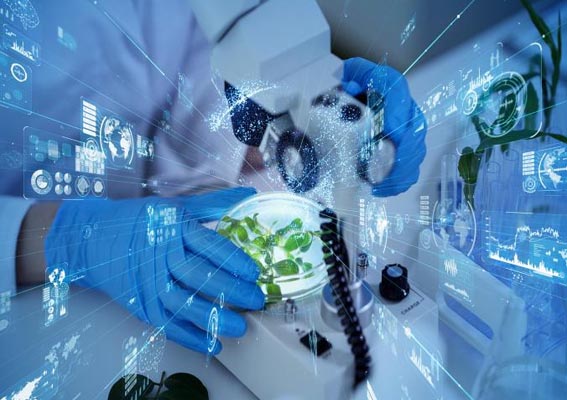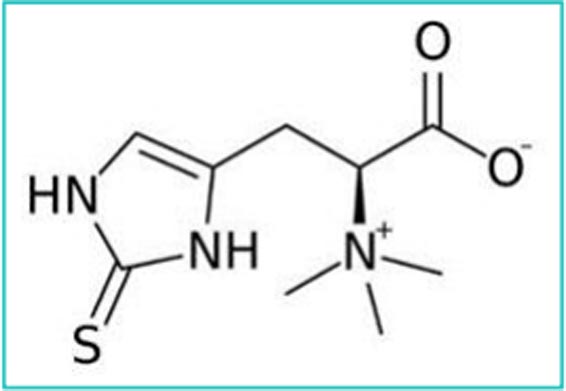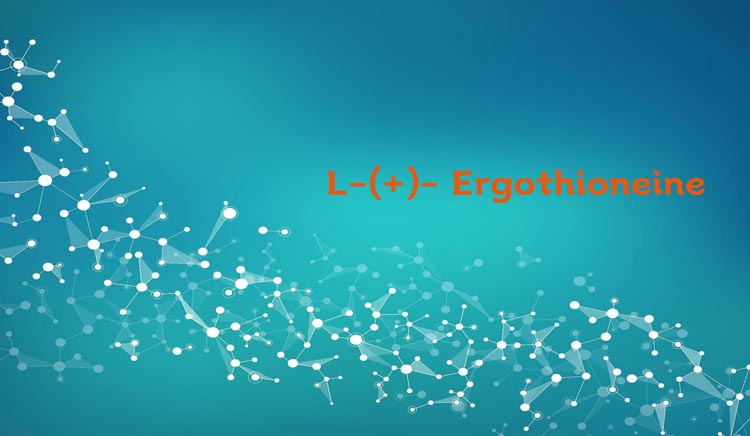
L-Ergothioneine (ERGO) is an unusual thio-histidine betaine amino acid discovered a century ago. In humans, ERGO has been shown to accumulate in various cells and tissues at high concentrations (100 μ M to 2 mM)1. But human body does not synthesize ERGO, so has to obtain it from diet. Edible mushrooms are the major dietary source of ERGO2. In recent years, ERGO has gained considerable attention by the scientific community, including some of the world- renowned researchers including Drs. Bruce Ames, Solomon Snyder and Barry Halliwell, due to its unique properties and biological functions.

A major discovery in 2005 found that ERGO in mammals is taken up by a specialized ERGO transporter protein (ETT) OCTN1(encoded by gene SLC22A4)3. OCTN1 occurs in almost all tissues of human body4.
The presence of a specific transporter for ERGO that makes it highly bioavailable and avidly retained strongly indicates that humans gain benefit from obtaining and retaining it in their tissues. Specific transporters are rarely present for non-nutrient bioactive compounds such as polyphenols, which are rapidly metabolized and excreted from the body. ERGO is very stable under physiological conditions, hence it does not readily undergo auto-oxidation as rapidly as other thiol antioxidants such as glutathione powder that can generate free radicals in the process.

ERGO has long been known to play a significant role as an antioxidant. Early in vitro studies have demonstrated the abilities of ERGO to scavenge reactive oxygen species and reactive nitrogen species such as hydroxyl radicals, hypochlorous acid, singlet oxygen and peroxynitrite. Evidence accumulated in recent years suggest that ERGO may function as a physiological antioxidant and cytoprotectant5. The distribution of ERGO in the body reveals that the compound is preferentially accumulated in organs and cells with high levels of oxidative stress such as liver, kidneys and erythrocytes. It is also present in high concentrations in mitochondria, a major source of oxidants. Lack of ERGO transporter results in oxidative damage to proteins, lipids, and DNA, and higher levels of mortality in human cells.
Based on a range of in vitro and in vivo studies, ERGO has exhibited the ability to modulate inflammation, protect against acute respiratory distress syndrome, prevent endothelial dysfunction, protect against ischemia and reperfusion injury, protect against neuronal damage, counteract iron dysregulation, hinder lung and liver fibrosis, and mitigate damage to the lungs, kidneys, liver, gastrointestinal tract, and testis, amongst many others. In a study conducted in Sweden involving over 3200 adult men and women, 1 12 plasma metabolites were measured. ERGO was found to be most strongly associated with decreased risk of CVD and reduced mortality after 21.4 years of follow-up6. More recently, ERGO was proposed by Dr. Halliwell as a potential application in the treatment of COVID- 19. It could be used as a therapeutic to reduce the severity and mortality of COVID- 19, especially in the elderly and those with underlying health conditions7.
Dr. Bruce Ames recently suggested that ERGO should be considered a 'longevity vitamin', based on the presence of ERGO in human tissues, the essentiality of its transport system, its possible involvement in CVD prevention, its antioxidant, and cytoprotective activities8. Americans have been estimated to consume less ERGO ( 1.1 mg/day) than individuals in four European countries including Finland, France, Ireland and Italy (up to 4.6 mg/day in Italy). The lower intakes of ERGO were shown to coincide with a greater prevalence of chronic neurological diseases of aging and lower life expectancies9. Very recently, low plasma ERGO levels were associated with neurodegeneration and cerebrovascular disease in dementia10.
Studies demonstrated that L-ergothioneine protects skin cells from UV-irradiation11. Scientific data have also showed that L-ergothioneine presented anti-inflammatory, antioxidant, photoprotective, antimicrobial, anti-tyrosinase, anti-elastase, and anti-collagenase activities. It can be utilized as ingredient to suppress the severity of inflammatory skin diseases (e.g., eczema, seborrheic dermatitis, and psoriasis), offer photoprotection to the skin, and correct Hyperpigmentation12. L-ergothioneine is considered as one of the top botanical ingredients used in anti-aging creams currently on the market13. It has been used as a "secret ingredient" by several high-end cosmetic brands.
ERGO is produced via fermentation using non-genetically modified yeast. It has achieved Generally Recognized As Safe (GRAS) status through self-affirmed GRAS process. A number of high-dose studies have indicated that ERGO is safe for human consumption at levels far in excess of those likely to be encountered in foodstuffs.
And it has been declared safe by the European Food Standards Agency (EFSA) even for young children, pregnant and breastfeeding women14.

1. Cheah, I. K.; Halliwell, B., Ergothioneine; antioxidant potential, physiological function and role in disease. Biochim Biophys Acta 2012, 1822 (5), 784-93.
2. Beelman, R. B.; Kalaras, M. D.; Richie, J. P., Jr., Micronutrients and Bioactive Compounds in Mushrooms: A Recipe for Healthy Aging? Nutr Today 2019, 54 ( 1), 16-22.
3. Grundemann, D.; Harlfinger, S.; Golz, S.; Geerts, A.; Lazar, A.; Berkels, R.; Jung, N.; Rubbert, A.; Schomig, E., Discovery of the ergothioneine transporter. Proc Natl Acad Sci U S A 2005, 10 (14), 5256-61.
4. Halliwell, B.; Cheah, I. K.; Drum, C Ergothioneine, an adaptive antioxidant for the protection of injured tissues? A hypothesis. Biochem Biophys Res Commun 2016, 470 (2), 245-250.
5. Borodina, I.; Kenny, L. C.; McCarthy, C. M.; Paramasivan, K.; Pretorius, E.; Roberts, T. J.; van der Hoek, S. A.; Kell, D. B., The biology of ergothioneine, an antioxidant nutraceutical. Nutr Res Rev 2020, 1-28.
6. Smith, E.; Ottosson, F.; Hellstrand, S.; Ericson, U.; Orho-Melander, M.; Fernandez, C.; Melander, O., Ergothioneine is associated with reduced mortality and decreased risk of cardiovascular disease. Heart 2020, 106 (9), 691-697.
7. Cheah, I. K.; Halliwell, B., Could Ergothioneine Aid in the Treatment of Coronavirus Patients? Antioxidants (Basel) 2020, 9 (7), 595.
8. Ames, B. N., Prolonging healthy aging: Longevity vitamins and proteins. Proc Natl Acad Sci U S A 2018, 1 15 (43), 10836-10844.
9. Beelman, R. B.; Kalaras, M. D.; Phillips, A. T.; Richie, J. P., Jr., Is ergothioneine a 'longevity vitamin' limited in the American diet? J Nutr Sci 2020, 9, e52.
10. Wu, L. Y.; Cheah, I. K.; Chong, J. R.; Chai, Y. L.; Tan, J. Y.; Hilal, S.; Vrooman, H.; Chen, C. P.; Halliwell, B.; Lai, M. K. P., Low plasma ergothioneine levels are associated with neurodegeneration and cerebrovascular disease in dementia. Free Radic Biol Med 2021, 177, 201-211.
11. Bazela, K.; Solyga-Zurek, A.; Debowska, R.; Rogiewicz, K.; Bartnik, E.; Eris, I., L-Ergothioneine protects skin cells against UV- induced damage — a preliminary study. Cosmetics 2014, 1 ( 1), 51-60.
12. Taofiq, O.; Barreiro, M. F.; Ferreira, I., The role of bioactive compounds and other metabolites from mushrooms against skin disorders - A systematic review assessing their cosmeceutical and nutricosmetic outcomes. Curr Med Chem 2020, 27 (41), 6926-6965.
13. Cronin, H.; Draelos, Z. D., Top 10 botanical ingredients in 2010 anti-aging creams. J Cosmet Dermatol 2010, 9 (3), 218-25.
14. Turck D, Bresson JL, Burlingame B, et al. Statement on the safety of synthetic l-ergothioneine as a novel food – supplementary dietary exposure and safety assessment for infants and young children, pregnant and breastfeeding women. EFSA Journal 2017, 15(11), e05060.